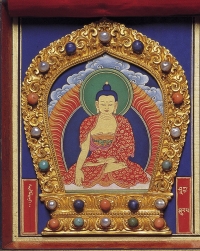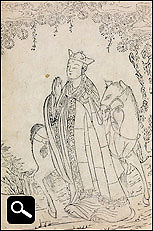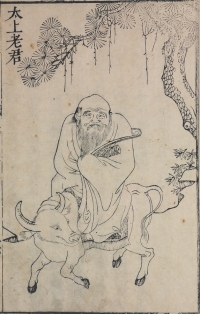TELDAP Collections
| Heaven, Earth, and Beyond: Prints and Illustrations of Confucian, Buddhist, and Taoist Figures |
|
Confucian, Buddhist and Daoist philosophies form the foundation of Chinese culture.
Śākyamuni (565-486 BCE) is the founder of Buddhism, who was the sun of the King Śuddhodana of Kapilavastū (in the south of Nepal), and he was called Siddhārtha Gautama while he was a prince. "Śākyamuni", which means "sage of the Shakyas," is a name given to him after he was enlightened. He had realized grieves and uncertainties of life since he was a child, and swore to look for a way to relieve. When he was 29, he left the palace and became a monk and practiced for 6 years near the river Neranjarā. He attained the Great Enlightenment at 35 under a pipal tree near Buddhagaya. Then he spent 40 years preaching about The Four Noble Truth, Noble Eightfold Path, and the Six Pāramitā near Rajagrha, Sravasti, and Mrgadava. He died under two sāla trees outside Kuwinagara.
Xuanzang (600-664CE), whose mundane name was Chen Yi, was born in Luoyang, Henan. His family was poor, and he studied Buddhism in Louyang with his elder brothers in Jingtu Temple. He had already understood all the teachings in China when he was about 20. However, he thought that he didn't understand the ultimate truth of Buddhism, he then decided to go to India for further study. He started his journey throughout five regions of ancient India from 629 to 645 CE. He learned many commentaries of sutras from Master Jiexian and was famous in Tienzhu for successful convinced many local monks in Kannauj. Latter he was given the title of Mahāyānadeva. After he went back to China, he started translating Buddhist scriptures in Hongfu Temple of Changan and Yuhua Temple. He was the greatest translator in Chinese Buddhism and he had translated 75 sets and 1135 volumes of Buddhist scriptures before he died, including the famous "Yogacara-bhumi", "Kowa-wastra," and "Maha-prajñaparamita-sutra". In addition, he was also a famous traveler and his important historical and geographical oral work of “Datang xiyuji (The Great Tang Records on the Western Regions)" recorded his knowledge about the customs of places where he had traveled. And the story of this pilgrimage became the theme of novels, such as the Wu Chengen's Xiyouji (Journey to the West) is one of famous works in Ming dynasty, which describes that Xuanzang's pilgrimage with his three disciples (Sunwukong, Zhubajie and Shawujing) and they encountered the 81 obstacles during their journey.
Laozi, whose name was Lier and style name was Poyang, and also called Laodan, was a philosopher in the late of Spring and Autumn Period. He was the founder of Daoism school, where he is called "The Supreme Lord", and is regarded as the father of religious Daoism. He was the author of Daodejing. According to the "Sancai Tuhui", he started to reincarnate since the Three Sovereigns period. It is said that he was born from his mother's armpit under a plum tree, with an appearance of an immortal. When King Wen of Zhou was still the Xipo feudal prince, Laozi was offered a position as a librarian in the royal library. In the time of King Wu, he was the manager of decrees and relics and later he retired as a hermit in the time of King Zhou. It is said that after retired, when Laozi was going to leave through the Hangu Gate by a cattle wagon, the guard saw a purple cloud came from the east, and he knew a sage was going to pass there. He met Laozi and asked him to write a book, the famous Daodejing.
That Nüwa patched the sky and molded human is one of the remote Chinese myths. It circulated widely as folk literature before the Warring States period. In the picture of Lisaotu ("Illustrations of Encountering Sorrow"), Nüwa is depicted as a goddess with a snake body and a human head. It can transform into seventy different forms in a day. Sometimes Nüwa and Fuxi together are called "the Two Emperors". Fuxi was described as having a body of dragon and holding the sun in his hand, and Nüwa holding the moon. The folk calls her Empress Nüwa, and regarded her as the founder of marriage and the inventor of reed pipes. The story of Nüwa's moulding human and patching sky is told in Taipingyulan and Huainanzi. This painting is from "Tienwentu (Illustrations of Heavenly Questions)", depicting the scenes of Nüwa entwining on a pillar with her snake body and patching the sky with the five-color stones in her hand. This scene is adopted from the chapter of “Heavenly Questions" in Quyuan's Li-Sao("Encountering Sorrow" ).
Confucius (551-479BCE), whose name is Qui and style name is Zhongni, founder of Confucianism, taught his disciples about rituals and was known as the "Great Sage Teacher". Confucius' disciples collected his sayings and edited a book, Lun Yu (Analects of Confucious), which conveys the fundamental thoughts of Confucianism. None of the ancient books available depicts the appearance of Confucius. On limited information and through imaginations, the author of this book painted Confucius' half-length portrait. The Confucius in this portrait looks elegant and is dressed in a civilized manner with clasped hands held at breast level. According to Shi Ji (Records of Historian), Confucius has consulted Laozi about Dao and he taught Confucius the principle of humbleness and hiding one's wisdom. In this story, Confucius appraised Laozi by saying that "I know the ability of flying of a bird, the ability of swimming of a fish and the ability of running of a beast. Those who can run, can swim, and can fly could be captured by a nest. As to a dragon that flies above the cloud by wind, I do not know how one can capture it. As I understand, Laozi I met today is a dragon." One can see the respect Confucius paid to Laozi in this story. The picture "Confucius Asking Laozi about Propriety" is in "Shengmiao sidiantukao". The young scholar is Confucius, and the old sage with white hair and eyebrow is Laozi; this is a large meeting of Confucianism and Daoism.
"Ershisixiaoti shituhekan" is a well-known folk story of China, which is an important material for early education. This painting illustrating by Li Xitong, is about Laolaizi serving his parents piously. When he was 70, he still wore colorful clothes with five colors in order to please his parents. Sometimes he imitated the sound of baby's crying or he spilt in water on purpose; the atmosphere of his family is amicable.
|

















